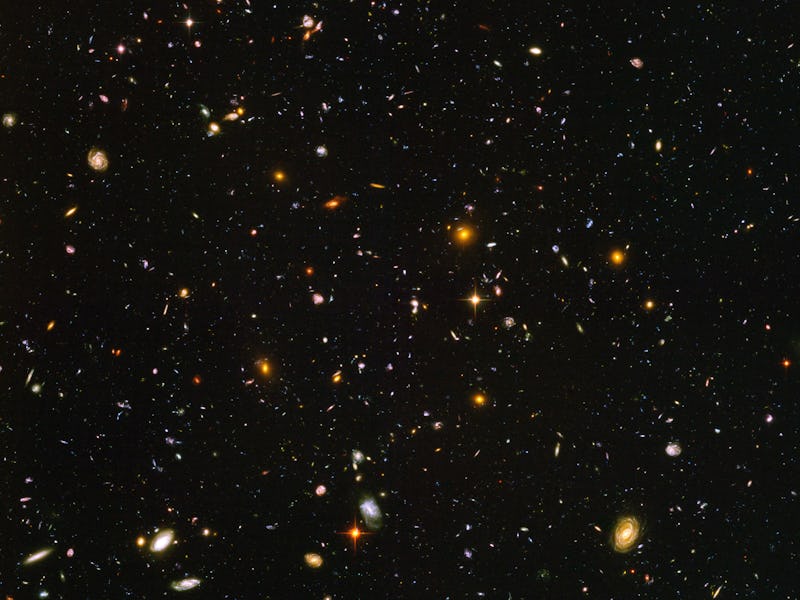A strange galaxy has no dark matter, and astronomers aren't sure why
The latest findings add to the mystery of the already elusive dark matter.

Dark matter is the most mysterious stuff in the universe. But one thing we know for sure about dark matter is that it’s there — until it’s not.
In a discovery detailed in an upcoming study to be published in the Monthly Notices of Astronomical Society, an international team of researchers discovered evidence of a galaxy that seems to have no dark matter, further adding to the mystery of the elusive force.
WHAT’S NEW — Pavel Mancera Piña, a researcher at the University of Groningen in the Netherlands, and his team started observing a group of galaxies the size of giant galaxies like the Milky Way, but with the luminosity of far smaller dwarf galaxies.
“When you look at the amount of stars they have, they’re not so many, about 1,000 times less than the Milky Way,” Piña tells Inverse. “But then the size of these galaxies is as extended as the Milky Way.”
These galaxies are known as ultra-diffuse dwarf galaxies.
The galaxy AGC 114905 is captured in this image, with the stellar emissions highlighted in blue and the neutral hydrogen in green.
The team wanted to investigate how these galaxies form, but they discovered something even more odd about them.
Using the Very Large Array in New Mexico, they observed a galaxy dubbed AGC 114905 for a total of 40 hours between July and October 2020. The team measured how fast the galaxy was rotating to calculate its total mass.
A galaxy’s mass is typically made up of gas, stars, and dark matter.
“When you look at normal galaxies, you will find that they are rotating much faster than what you would expect considering the amount of gas and stars they have,” Piña says. “And therefore we infer that there should be some amount of mass that we cannot observe, but that should be there because otherwise, the galaxy would be rotating at a slower rate.”
The missing mass is dark matter, which cannot be observed, but its presence can be inferred.
However, galaxy AGC 114905 was rotating at precisely the expected speed based on the amount of observable, regular matter in the galaxy. The team behind the new study suggests that this galaxy, along with five others that they had observed before, may have little to no dark matter in them.
HERE’S THE BACKGROUND — Dark matter is a type of matter that doesn’t reflect, emit, or absorb light, and may only interact with other matter through gravity. Although hidden, dark matter makes up around 27 percent of all mass in the universe. Around 68 percent of the remaining mass is dark energy, with just five percent left to ordinary “baryonic” matter, like the stuff we see every day.
Scientists have not been able to observe dark matter, but they know it’s there given its effect on the motion of stars and galaxies. The gravitational force of dark matter can be observed simply because the force that scientists note does not equate to the amount of ordinary matter that they see. But the properties of dark matter are shrouded in mystery.
This isn’t the first time scientists observed galaxies that seemed to be missing their dark matter. In 2018, astronomers observed a galaxy named NGC 1052-DF2, which appeared to have a meager percentage of dark matter.
“This seems to add to the evidence that there are some galaxies without dark matter,” Piña says.
But scientists aren’t exactly sure whether these galaxies formed without dark matter or if it was somehow stripped from the galaxy at some point. In the case of AGC 114905, there are no surrounding galaxies that would be capable of sucking the dark matter out of it.
“In principle, all galaxies should inhabit very massive dark matter halos,” Piña says. “So it’s not clear how you can form a galaxy without it.”
WHAT’S NEXT — The scientists behind the new study are hoping to further investigate the properties of the galaxy to find out why it’s missing its dark matter, and how it came to be.
They plan on looking at the galaxy’s stars in more detail to see if the stars are somehow different from stars located in galaxies that do have dark matter.
This may lead scientists closer to understanding dark matter.
“I think it adds to the mystery of dark matter,” Piña says. “But at the same time, it may give us some hope to understand it better.”
Abstract: We present new HI interferometric observations of the gas-rich ultra-diffuse galaxy AGC 114905, which previous work, based on low-resolution data, identified as an outlier of the baryonic Tully-Fisher relation. The new observations, at a spatial resolution ∼2.5 times higher than before, reveal a regular HI disc rotating at about 23 km/s. Our kinematic parameters, recovered with a robust 3D kinematic modelling fitting technique, show that the flat part of the rotation curve is reached. Intriguingly, the rotation curve can be explained almost entirely by the baryonic mass distribution alone. We show that a standard cold dark matter halo that follows the concentration-halo mass relation fails to reproduce the amplitude of the rotation curve by a large margin. Only a halo with an extremely (and arguably unfeasible) low concentration reaches agreement with the data. We also find that the rotation curve of AGC 114905 deviates strongly from the predictions of Modified Newtonian dynamics. The inclination of the galaxy, which is measured independently from our modelling, remains the largest uncertainty in our analysis, but the associated errors are not large enough to reconcile the galaxy with the expectations of cold dark matter or Modified Newtonian dynamics.
This article was originally published on